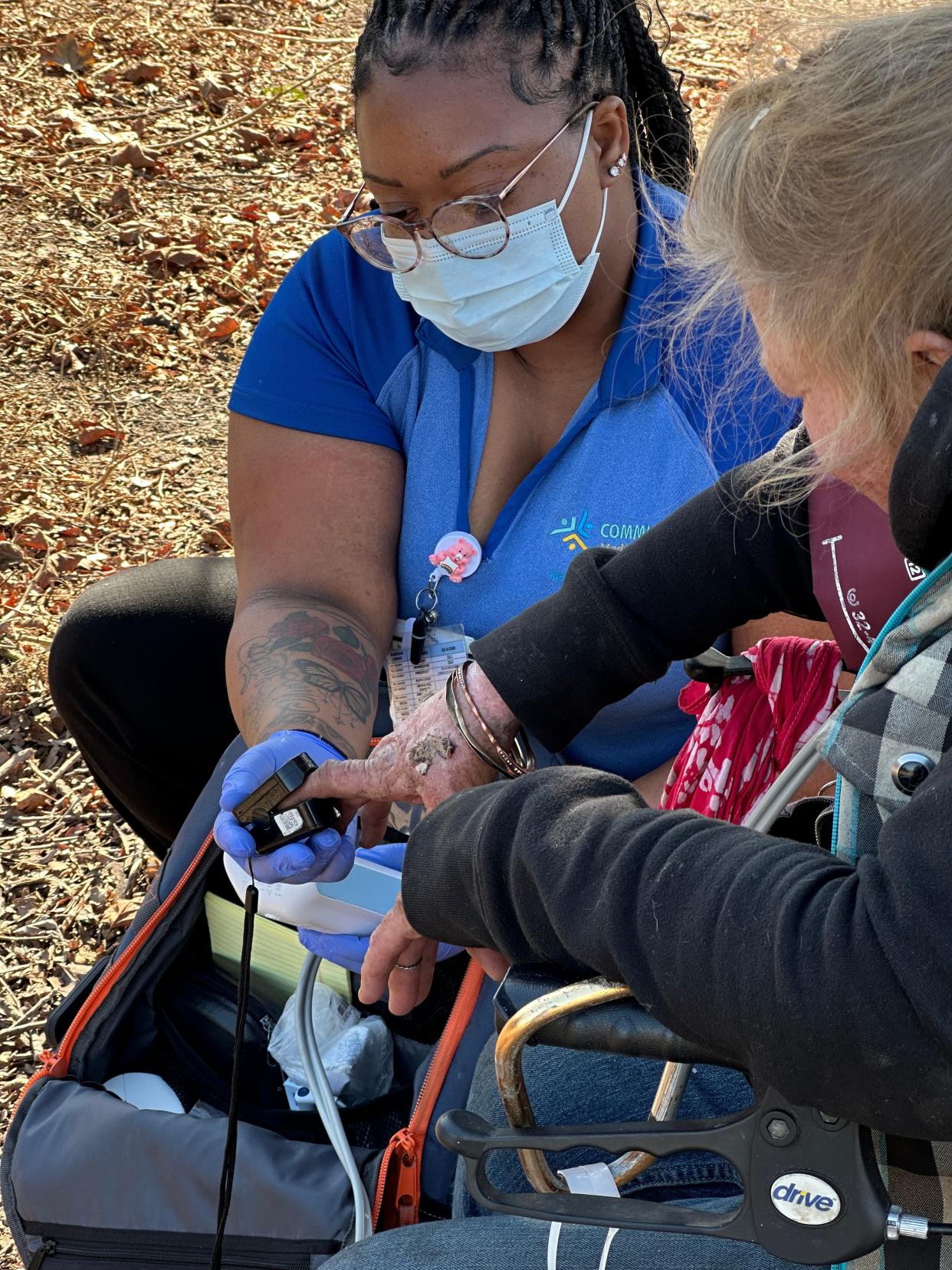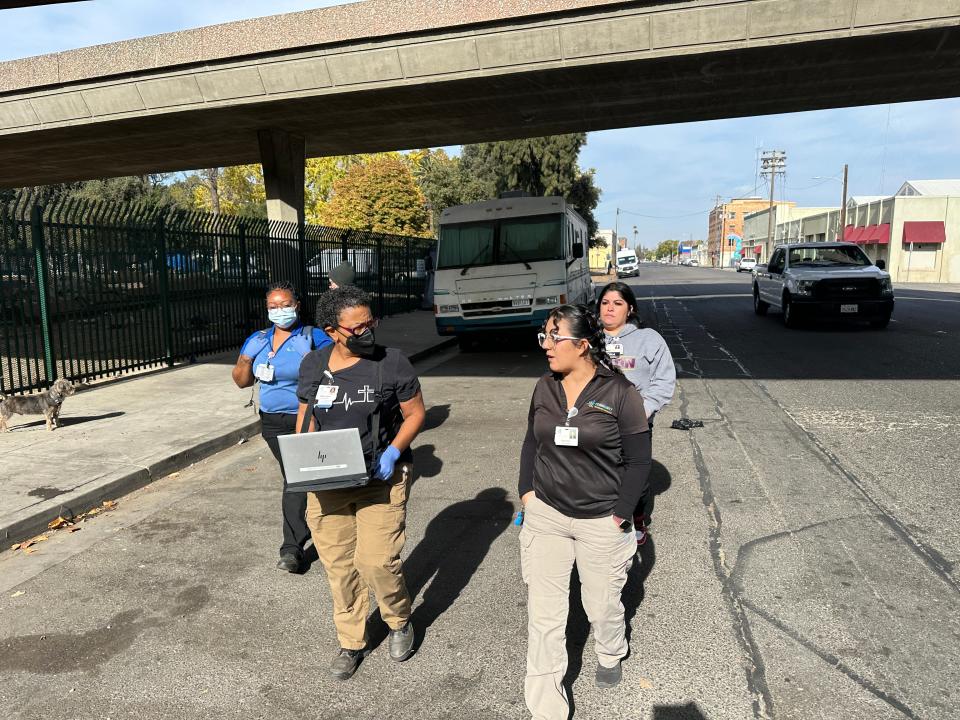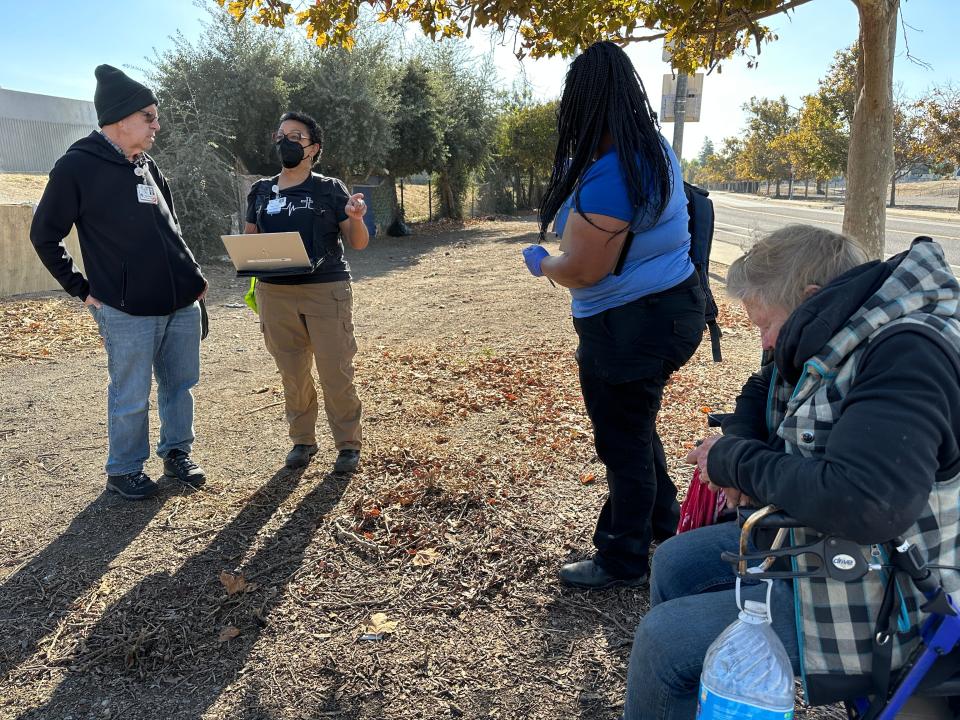This medical team helps Stockton's most vulnerable residents. Here's how they're making an impact

Deborah Scarbone momentarily ditched her walker a few months ago.
It held her back when she lunged to catch a palm-sized white chihuahua-mix puppy being thrown at her from a moving car on Feather River Drive in Stockton.
She decided to keep him, and named the dog “Cane.”
The dog’s another mouth to feed, but she’s happy to care for the little guy on top of her other worries.
Scarbone, 62, lives on the streets of Stockton with her husband, James, 52. She struggles with high blood pressure, diabetes, addiction and growing abscesses on her hands.
When she’s lucky, local programs to help unhoused folks come to check on her.
The couple have lived in camps around Stockton for nearly two decades. James said the city has been good to them, even though some Stocktonians occasionally photograph them “like they’re on display.”
“It’s like we’re on stage or something,” said James. “Just leave my life alone.”

Even worse, sometimes glass bottles or trash are thrown at them by random malefactors. Others have burned down their city-issued porta-potties, trying to force their camp to move.
Under the circumstances, the Scarbones keep their space as tidy as possible. Inside, shoes are lined up neatly under a cot and blankets are hung and ready for use. Everything in their tent was neat and in place when Community Medical Centers’ CareLink teams made an unannounced visit recently.
The Scarbones have utilized CMC’s CareLink medical program for three years. A few times a week, CMC teams seek out unhoused Stockton residents like James and Deborah to give campers enough time and resources to pack up their campsites before being forced out by cleanup crews.
“(CareLink mobile services) are here to offer big and small things for people living on the streets,” said Sandra Garcia, a CMC medical assistant. “Sometimes it’s just passing out food and water while checking on the people we know are out here.”
CareLink is an umbrella term for all the CMC mobile services, spokesman Roger Phillips said.
Composed of CMC nurse practitioners and medical assistants/case managers, CareLink’s teams offer medical and social services to returning and new unhoused patients in Stockton, Lodi, Tracy and Manteca.
Right now there are the medical vans for Garcia’s team and others like it, such as behavioral health mobile teams. In the near future CMC plans to send out mobile mammogram and dental teams to help families like the Scarbones.
Because of the constant shuffle of encampment clearings, the medical and social workers at the Stockton Homeless Shelter often struggle to find their patients in time.
Keeping up with the area’s unhoused community members is a daunting task, but the program at the very least attempts to provide a level of care to the region’s most vulnerable population.
In early November, CVJC accompanied CMC’s mobile care teams as they searched for their patients in Stockton.

Building community trust
When CareLink first started in 2001, a lot of people didn’t trust it, Deborah explained.
According to Deborah, it took some convincing and leading by example on her part, in order to get her friends to interact with the program.
“I’d tell them, ‘Just watch what I do.’ That’s when they'd realize (CMC) will be regular,” she said. “I really pushed to get it out here. I keep gathering people and telling them to ask questions.”
Eventually, she said, people began to trust nurse practitioner Stephanie DeRosa and the CMC vans.
DeRosa’s patients take the lead any time she encounters them. “They don’t have to accept treatment, but I at least approach them, ask if I can take a look. Sometimes that’s all you can do,” she said.
When DeRosa does get the chance to offer medical care, she is no-nonsense and walks patients through the steps they’ll follow to further their healing. She knows to be cautious and never go out in the field alone, but she is diligent about finding space for just her and the patient to speak privately.
“(CareLink) saved my ass,” James acknowledged, when asked about the impact the program has made. “I had all kinds of abscesses. And Deborah! She almost died on me a couple of times. If it wasn’t for (CareLink) I would’ve lost her.”
After visiting the Scarbones, DeRosa went to check on a man who was reported to have a purple arm. When she got to him, she decided the man needed to be seen in an emergency room. Even though she wasn’t able to assist the patient, she stuck around to help him make plans to get him to a hospital.
“I got him to agree to let his son take him in,” DeRosa said.
Scarbone recalled a friend with a hernia who would walk around doubled over. She said once he approached CMC, they were able to get him to outpatient surgery. Her friend is now employed and off the streets.
Finding their clients
During morning roundups at the Stockton Homeless Shelter, the group of program representatives plan out routes for each team.
“It’s hard to do outreach and find people because they keep getting chased away,” said Dennis Buettner, an outreach worker for San Joaquin County Behavioral Health. He receives a list of to-be-cleared camps from Caltrans’ District 10 Office of Homelessness and Encampments.
Buettner also serves as coordinator for the large array of community groups dedicated to meeting several times a week in the parking lots by the Stockton Homeless Shelter and St. Mary’s Dining Hall, DeRosa told CVJC.
Together, the group talks over where certain clients were last seen and who needs which services. Sometimes it’s a small group with the CMC CareLink teams and county behavioral services, other days veterinarians and the Mobile Community Response Teamwill join.
At the morning meeting, DeRosa’s team heard Deborah and James were last seen camped out by a park in Stockton.
They were able to find the Scarbones across the street from the park. When they did find them, DeRosa shouted an enthusiastic hello, and was promptly greeted by her patients.
“James!” Deborah called from her campfire, “Stephanie is here!” Deborah then immediately showed the nurse her badly-torn hands patched with fast food napkins. DeRosa and Mia Bledsoe, a medical assistant, wasted no time and began taking Deborah’s blood pressure while chatting about the family’s last few months.
“It’s me, my husband, Joe and our street son,” Deborah told CVJC.
She was the only one to accept care that day. James mentioned their longtime camp mate and U.S. Navy veteran Joe Turner Meashay Jr. could use medical attention for his leg, but he didn’t interact with the CMC mobile unit.
Joe told CVJC his leg had been clipped by shotgun pellets eight years ago when their camp was attacked. His leg still gives him trouble, so he keeps it wrapped.
Without consent, DeRosa and Bledsoe weren’t allowed to approach Meashay to check on his wound. Instead, they continued to set Deborah up with prescriptions, check-up appointments and referrals to a dermatologist for her hands.
Treating an on-the-move population
People with homes likely receive similar medical care as the treatment CMC offers unhoused residents in Stockton, James Scarbone told CVJC.
“The only difference is that we’re out here,” he said. “It’s the police department and Caltrans that are our worst nightmare.”
Deborah Scarbone remembers 11 Stockton police cars escorted Caltrans the last time their camp was cleared out.
“The number of camps set to be cleared does not dictate how many cars come out,” said Stockton Police Department spokesman Omer Edhah. However, he also said the amount of officers who showed up that day were likely scheduled to assist with other clearings in the area weeks before, when the camp had more residents.
The group was forced to move from their last spot, a few hundred feet away from their current camp, on Oct. 4, Deborah said. Caltrans woke the camp up at six in the morning, after providing the obligatory 48 hours’ notice for clearing. Everything, including IDs and prescriptions, were tossed, she said.
It’s common to hear patients are woken up by Caltrans workers and told to grab what they can in the next 15 to 20 minutes before trucks start clearing, said CMC medical assistant Krystle Rodriguez.
“They give us, maybe, a three-day notice to secure a new camp, find whatever is left,” James said.
“Imagine having to do that with your house! This all happens in 32 hours, and at some point we gotta sleep. You gotta remember, what we do in 12 or 16 hours, you can do in 8. How are we supposed to get ahead doing this every other month?”
Caltrans labels and collects personal belongings left behind at encampments, holds the items for 60 days or until they are retrieved and posts a phone number to call to arrange retrieval,Caltrans District 10 Encampment Coordinator Bob Highfill said in an email statement.
James alleged that Caltrans often doesn’t hold their things for the 60 days like they’re supposed to, and he often wastes a whole day discovering this.
This may be due to Caltrans policy making it clear to employees and contractors that they are not required to sort through and attempt to remove things and may dispose of entire piles of belongings.
Highfill said workers are instructed to toss belongings of “apparent value worth less than $50; personal property that is a health or safety hazard, or not in plain sight.” Backpacks or closed containers that a Caltrans hazmat specialist deems unsafe are also disposed of, along with belongings co-mingling with needles or human waste.
When Caltrans posts a notice, James said his main priorities are to gather blankets, tarps, tents, and food. Since he is the only able-bodied person in their camp, he focuses on the necessities and hopes the others will pack what they can carry.
Medicines and other small things don’t make James’ list, but CMC mobile teams are able to help prescribe refills and put them in touch with social security and other offices to get ID cards reissued.
Regardless of the challenges, CareLink meets unhoused families wherever they are, providing care without judgment.
“I give out my number so they can call when they need something,” said Garcia. “The mobile services are perfect for meeting them wherever they’re at. This job is where I’m meant to be, out in the field like this.”
If you are, or know someone living in transitional housing or on the street in the greater Stockton area and need low or no-cost health care or assistance registering for insurance; you can reach the CareLink team at (209)-954-7702 or by visiting one of their locations.
Other options are Stockton Shelter for the Homeless and St. Mary’s Dining Hall on the corner of West Sonora Street and South Harrison Street, where trained behavioral and medical services personnel are available.
Vivienne Aguilar is the health equity reporter for the Central Valley Journalism Collaborative, a nonprofit newsroom based in Merced, in collaboration with the California Health Care Foundation (CHCF).
This article originally appeared on Visalia Times-Delta: This medical team helps Stockton's most vulnerable residents

